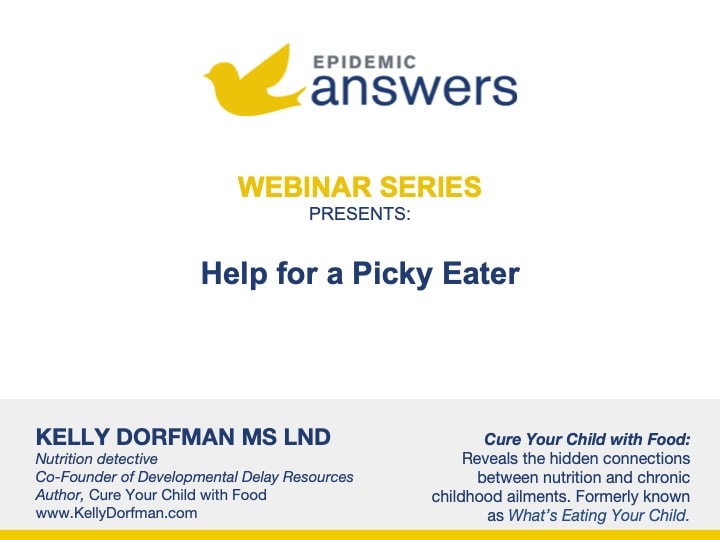In this blog post Kelly Dorfman, MS, LND, discusses child malnutrition in the form of empty-calorie malnutrition.
Child malnutrition is often associated with the image of a thin, forlorn child with a distended belly. Another kind of malnutrition, with high and empty calories, runs rampant in America, among people who never experience deprivation. Children with developmental delays are especially susceptible to this type of malnutrition because they tend to be picky eaters or may be on restricted diets for the treatment of allergies or autism.
What Is High- or Empty-Calorie Malnutrition?
A person can gain weight eating excessive calories consisting only of bread and French fries, missing the nutrients needed for optimal neurological development. During critical brain development periods, such a diet can cause permanent damage due to lack of essential vitamin and mineral building blocks.
Picky eaters may eat too little food or suffer from empty calorie malnutrition by eating junk foods with excess calories but few nutrients. If their intake is poor over a long enough period, a type of anorexia or growth hormone deficiency can develop.
Anorexia in developmentally delayed children represents a combination of the inability to sense hunger, tactile defensiveness in the mouth, and malnutrition. Insufficient zinc, vitamin B1 and other nutrients cause decreased taste acuity and poor appetite.
Is Your Child Malnourished?
Does he/she look malnourished? Visual diagnosis, a dying art, tells us that kids in good nutritional shape are vibrant and have good coloring.
Professionals often tell concerned parents not to worry as long as a pale, lethargic fussy eater is gaining weight. These well-meaning professionals often view parents as overly anxious or poor disciplinarians. Trust your instincts. Children who do not look healthy, and whose diets would not satisfy a healthy adult, are probably malnourished.
Are they eating fresh fruits and vegetables? Yes, children can and should eat vegetables. The fact that many don’t is not acceptable. Many of the antioxidants that support neurological health also protect us from chronic illness and are found in fresh produce.
Poorly nourished children often cannot taste the flavors of fruits and vegetables, which are subtle when compared to artificially enhanced, heavily salted or sweetened packaged foods.
For others the textures, colors and smells of fresh produce may be overwhelming. Work with a speech, occupational or oral motor therapist increases tolerance for dietary variety, improves speech and oral motor flexibility, and supports general health in sensory defensive children.
What Can I Do Until My Child Starts Eating Better?
Poor eating and malnutrition become a vicious cycle. Malnutrition impairs taste and appetite, and impaired taste and appetite lower one’s interest in good food.
To break this cycle, close the gap between what is needed and what is actually eaten by using nutritional supplements. While whole foods are better, supplements can provide the missing link in a child’s development.
When designing a supplement program, be sure to include all nutrients on the accompanying chart. This is a partial list of the most critical additions. Contact a nutritionally trained health professional if you have specific questions regarding your child. Be sure to choose a professional with experience using nutrients with children.
Minimum Daily Intake of Vitamins and Other Nutrients
| Nutrients | Function |
<Age 3 |
>Age 3 |
| Antioxidants: | |||
| Vitamin C | Protects against environmental. toxins. Supports immune system. | 100-250 mg | 250-1000 mg |
| Vitamin E | Detoxification. Protects fat-soluble tissues. | 30-100 IU | 60-200 IU |
| B Vitamins | Growth. Repair of neurological function. | 2-10x RDA | 2-10x RDA |
| Minerals: | |||
| Zinc | Immune function. Growth. Repair. Taste. Smell. Sexual maturation. | 5-12 mg | 12-20 mg |
| Calcium | Healthy bones and teeth. Calms nervous system. | ||
| Selenium |
Mercury displacement. | 50 mcg | 50-150 mcg |
| Chromium | Blood sugar stability. | 50 mcg | 50-150 mcg |
| Essential Fatty Acids | Cognitive neurological function.Calming of nervous system. | 1 tsp flaxseed or ½ teaspoon cod liver oil | 1-2 teaspoons cod liver oil |
About Kelly Dorfman MS LND
Kelly Dorfman is one of the world’s foremost experts on using nutrition therapeutically to improve brain function, energy and mood. Kelly’s special talent for integrating information from many sources and finding practical solutions has made her a popular speaker and workshop leader. She lectures extensively and is a member of Platform (formerly the National Speakers Association) and has been featured on numerous television programs including CNN’s American Morning.
Kelly’s award winning book, Cure Your Child With Food: The Hidden Connection Between Nutrition and Childhood Ailments (formerly known as What’s Eating Your Child) was given rave reviews by Publishers Weekly and the Washington Post.

As a go-to expert on nutrition issues, Kelly is frequently interviewed and quoted in the media. She has been featured in articles in The Wall Street Journal, Parade, Bethesda magazine, Living Without magazine, and the Huffington Post.
Kelly holds a master’s degree in nutrition/biology and is a licensed nutrition dietitian. She is a co-founder of Developmental Delay Resources, which has merged with Epidemic Answers. You can find out more about Kelly and her practice at kellydorfman.com
Still Looking for Answers?
Visit the Epidemic Answers Practitioner Directory to find a practitioner near you.
Join us inside our online membership community for parents, Healing Together, where you’ll find even more healing resources, expert guidance, and a community to support you every step of your child’s healing journey.




